A candidate nails the video interview: defiant answers, smooth English or Spanish, top-notch resume. But weeks later, the interview team discovers it wasn't the real candidate. A proxy was sent in the candidate's place, aided by fake documents and even deepfake capabilities.
These types of recruitment fraud strategies are becoming more common, especially in remote hiring. Fake identities, forged documents, and AI-generated deception are now real threats to the integrity of hiring sites.
In response, companies are looking to artificial intelligence in recruitment as both a protection and an investment. New technologies use AI-based fraud detection, candidate identity verification, document verification AI, and behavioral analysis in interviews to identify inconsistencies, detect fake identities, and verify information in real time.
In this article, we’ll explore how these technologies interact, from background screening to deepfake detection in recruitment process, and how organizations can use them responsibly, with a focus on ethical AI in hiring and data privacy in recruitment.
How artificial intelligence in recruitment detects what human intuition cannot
Recruitment fraud goes unnoticed: hidden behind professional resumes, well-crafted online profiles, and well-rehearsed interview answers. Human recruiters, with their empathy, contextual understanding, and intuition, tend to miss subtle warning signs that are difficult to detect without the help of technology. This is exactly where AI development services can help.
AI-powered fraud detection software scans massive amounts of data to look for inconsistencies between application data, biometric verification, and interview behavior indicators. By uncovering inconsistencies that traditional background checks might miss, these systems provide an ever-changing, dynamic defense against new forms of fraud.
Recruitment artificial intelligence tools, such as in-person behavioral analysis and biometric matching, serve as early warning systems that detect suspicious behavior in real time, allowing recruiters to assess candidates with greater confidence and accuracy.
Rather than augmenting human judgment, recruitment AI augments it, creating a more secure and trusted hiring process.
Deepfakes, proxies, and fake CVs: The modern face of hiring fraud
Remote working, once a competitive advantage, is now a risky option with an open door to changing scams. Traditional verification methods cannot compete with newer methods such as deepfakes, digital forgeries and proxy interviews.
Online anonymity gives candidates the ability to fake their identity or credentials without being easily detected. As a result, recruitment sites are under increasing pressure to verify not just what people say they are, but who they are.
Inside recruitment fraud: Four tactics HR teams must watch for
Hiring fraud doesn't always masquerade, sometimes it appears in the guise of a nicely crafted resume. Today's con artists are not amateurish in technique. They exploit loopholes in computerized hiring systems with horrifying effectiveness. The most common ways unscrupulous applicants get around traditional screening are as follows:
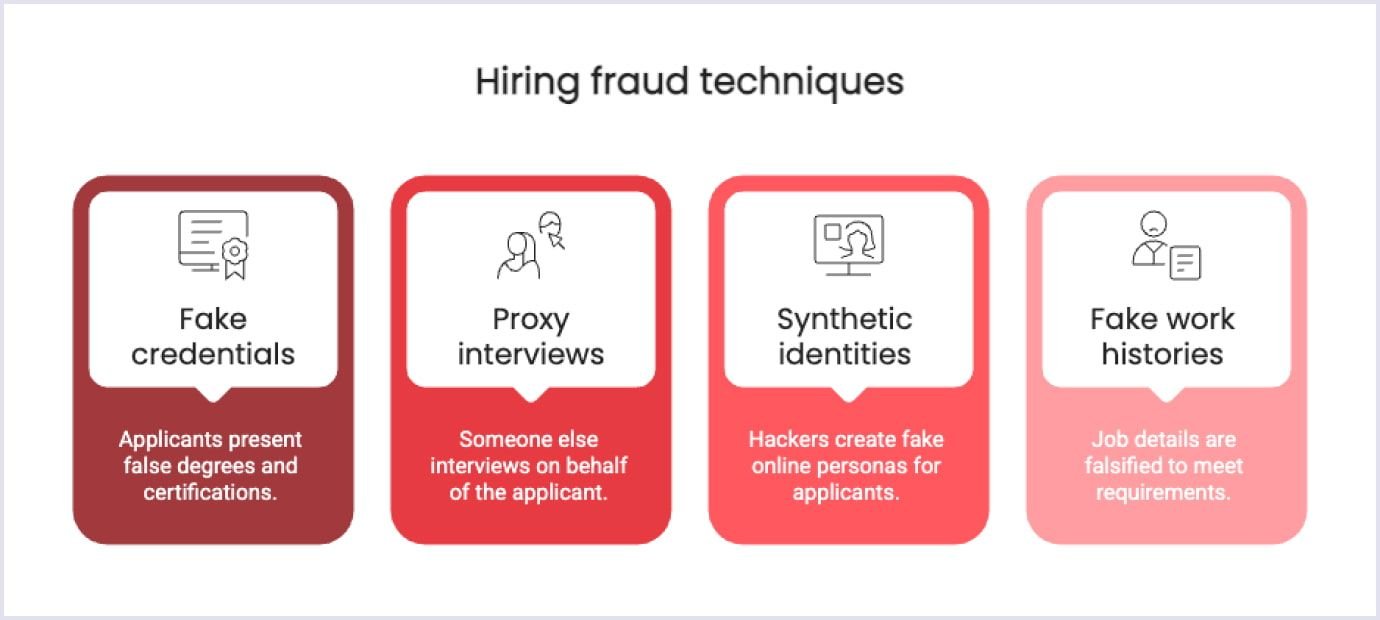
- Fake credentials. Applicants present fake degrees, certifications, or histories that cannot be confirmed by traditional reference checks.
- Proxy interviews. An interviewer other than the real applicant conducts the interview, at times using scripts, translation programs, or live coaching.
- Synthetic identities. Hackers create new online identities from bits of authentic information, making detection very difficult at initial screening.
- Fake work histories. Job titles, dates, and responsibilities are manipulated to match required positions, often supported by forged references or websites.
What makes them so effective is their realism, they're designed to blend in, not stand out. And until someone with the right tools comes along, most go unnoticed.
Real-life deception: When fake data fools investors and hiring teams alike
In 2024, the founder of San Francisco AI startup Baba Nadimpalli was charged with defrauding investors of more than $40 million by presenting them with fake financials, customers and business details. He created a virtual data room filled with false documents, including that even Google was a customer, to secure funds, and now faces up to 20 years in prison.
Although this is an investor situation, the tactics used: dummy records, web-based deception and superficial trust reflect what recruitment teams are increasingly encountering. AI-powered fraud detection programs, automated background screening and document authentication AI help detect such fraud by analysing behavioural patterns and cross-referencing data in real time. Such technology provides recruitment platforms with an intelligent, scalable defence before a fake candidate makes it through the process.
Effect on businesses
When an imposter candidate slips through, the damage doesn't stop at a bad hire, it echoes throughout the business. From missed deadlines to regulatory exposure, the effects can be dire:
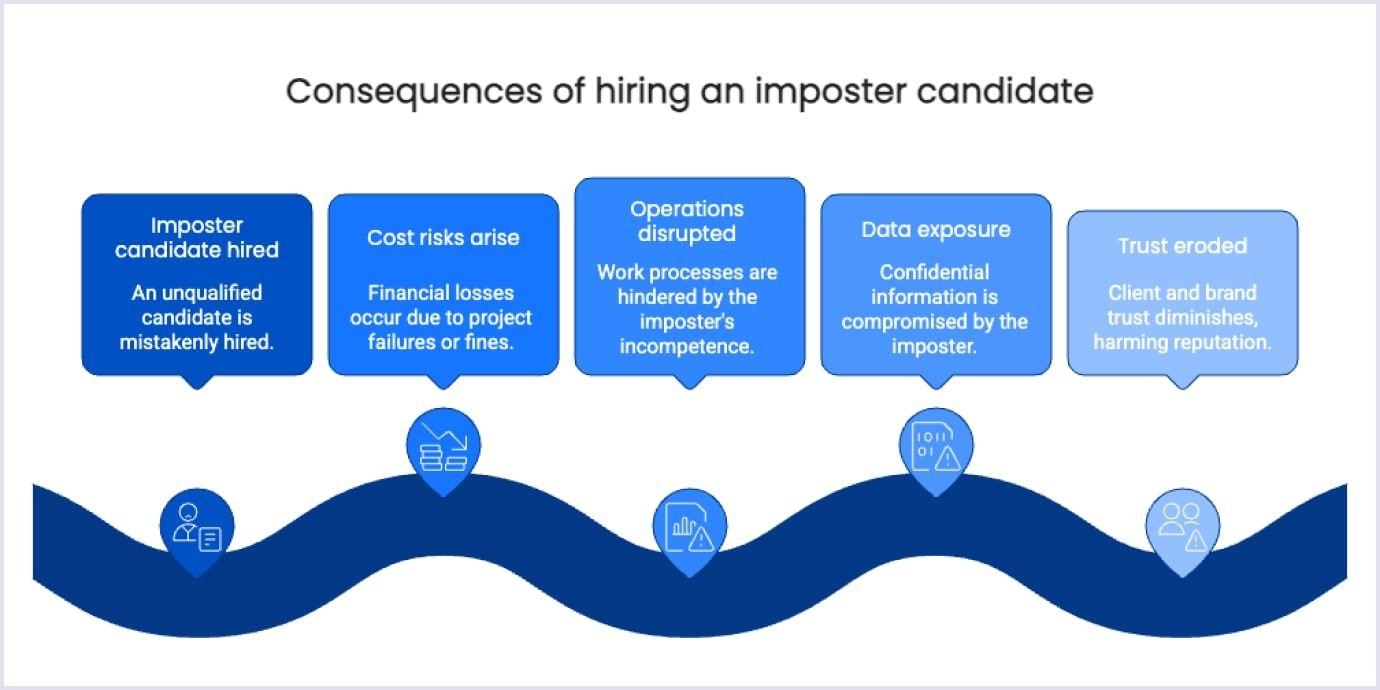
- Cost risks. Unqualified or unethical staff could lead to costly project failure, breach of contract, or regulatory fines.
- Disruption of operations. Teams are impacted when an imposter recruit works below expectations or introduces workflow bottlenecks due to the lack of real skills.
- Exposure of data. In security-related roles, fake candidates may expose confidential information, compromising the entire organization.
- Erosion of client and brand trust. String failure to hire can ruin a firm's reputation and make it more difficult to attract both clients and talent.
In a talent war, one poor hire is all it takes to fall behind. Not just in performance, but in trust, stability, and sustainability.

From illusion to insight: How AI exposes recruitment fraud
Fraudulent recruitment is a concerted strategy to circumvent traditional vetting. Recruitment AI equips platforms with precise tools to detect manipulation before it takes effect.
These AI fraud detection tools analyse data from multiple sources: documents, biometrics and behavioural data to detect inconsistencies that are imperceptible to human senses. Combined with automated background checks, these tools create a scalable barrier to fraudulent candidates. The result is faster, cleaner and safer hiring based on actual data, not guesswork.
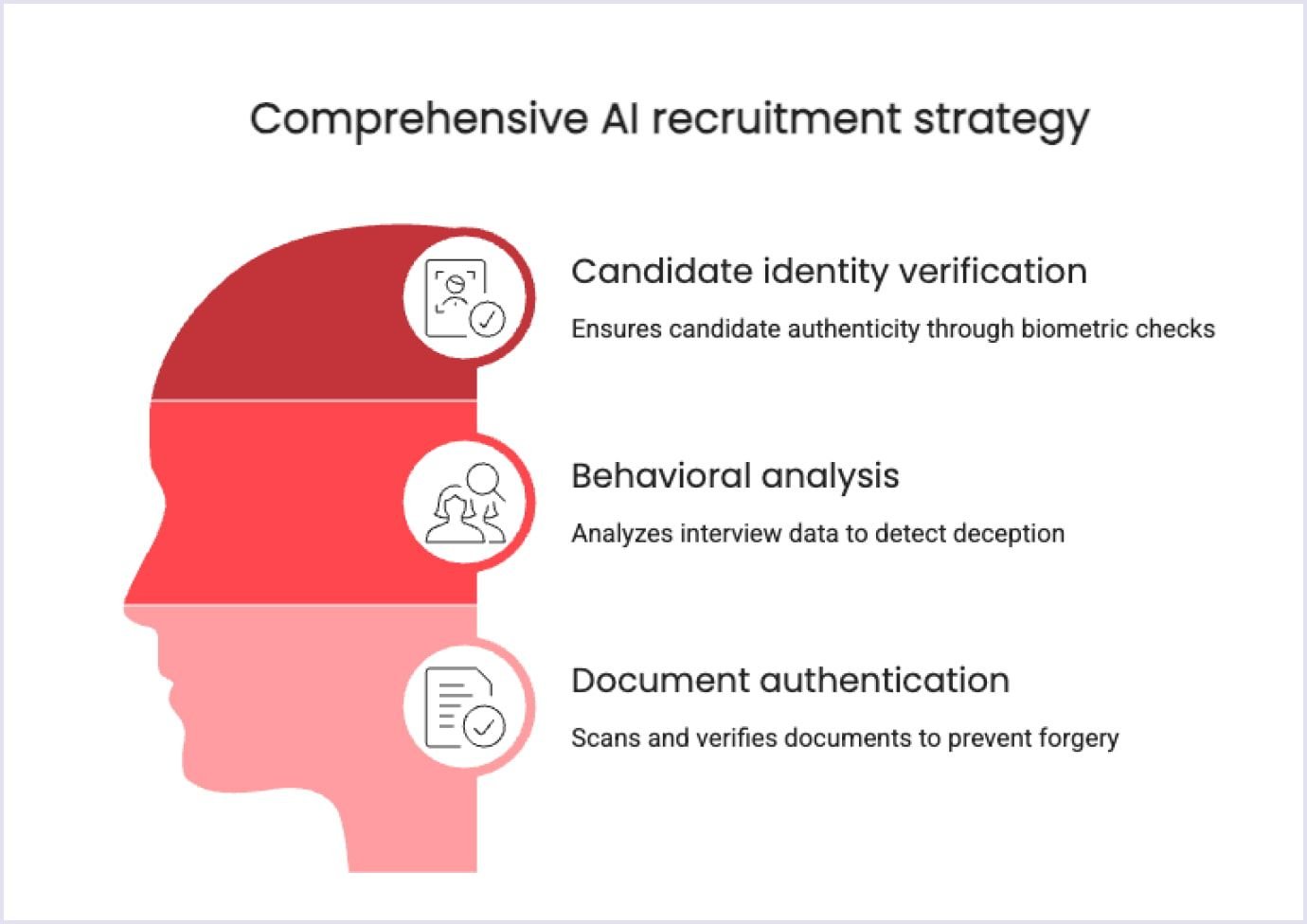
AI knows your candidate better than their resume
Candidate identity verification compares recent selfies or video clips with government IDs. They check for impersonation attempts using facial geometry, liveness detection and digital signatures. They also verify IDs by detecting barcodes, fonts and image layers. Early-stage recruitment deepfake detection ensures that these sites can weed out fake candidates at the interview level.
Behavioral analysis that catches fraud in real time
Machine learning in hiring facilitates the application of behavioural analysis at the interview stage, where computers check speech cadence, micro-expressions and gaze direction in real time. It finds deception cues such as live rehearsal or rehearsed answers. Role and context-specific behavioural baselines remove bias and maximise accuracy. Each interview is a minefield of data that is sifted through by intelligent automation, not a subjective human.
Fake docs, real damage: How AI authenticates what humans overlook
Document authentication AI extends surface-level scrutiny to scan files for metadata tampering, pixel anomalies, and forgery patterns. Whether a forged diploma, falsified employment verification, or manipulated transcript, the system alerts within seconds. Genuine documents are recorded for compliance, and doubtful ones are flagged for examination. Not only does this enable more intelligent hiring, but also enhances recruitment data privacy by reducing exposure to unverifiable data.
AI in candidate identity verification processes
Candidate vetting is not a one-time task. It's a continuous process that starts with application screening and extends into post-hire monitoring. AI-powered hiring enables verification streams that are faster, smarter, and precise.
Instead of discrete background checks or document screening, AI tools today process structured and unstructured data to build a complete and living picture of a candidate. These natively integrate with hiring platforms to eliminate blind spots and identify misrepresentation throughout the funnel.
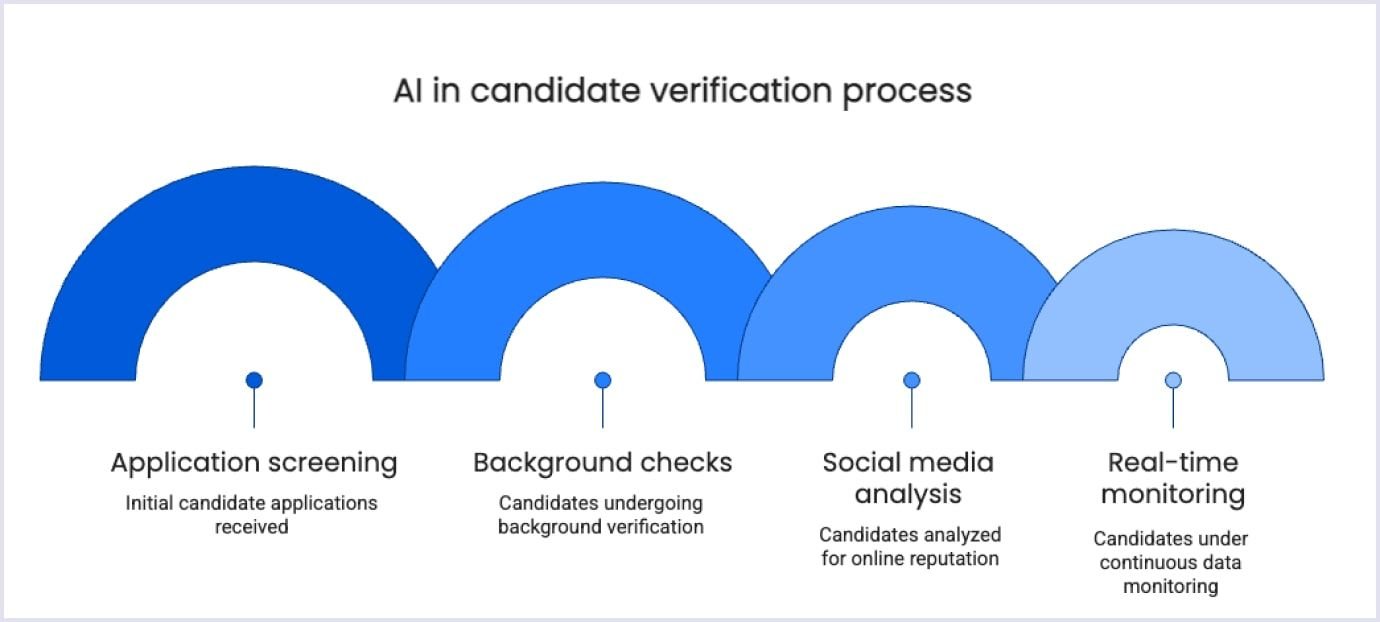
Background checks that verify more than titles and dates
AI-driven background checks cross-check employment history, educational credentials, and licenses in public, private, and proprietary databases within seconds. The software flags inconsistencies in timelines, detects duplicate assertions of work overlaps, and checks institutional authenticity, all on its own. It also detects inconsistencies between resumes and validated employment history, reducing the likelihood of fraud.
By converting background checks into real-time, data-intensive processes, AI reduces administrative overhead while improving accuracy and legal defensibility.
Social media and online footprint analysis for purpose
AI doesn't simply scan profiles, it reads online behavior. Natural language processing and image analysis-trained technology evaluates tone, coherence, and content on a candidate's social media profiles and online reputation. Recruiters can leverage it to evaluate professionalism, detect red flags (e.g., incoherent work histories), and identify patterns indicative of identity theft. Along with reputational risk, this level of analysis offers rich context for traditional reference checks and detects information that candidates may omit.
Real-time data monitoring that never stops verifying
Static verification is prone to post-hire surprises. Real-time monitoring software fueled by machine learning in hiring continues to monitor candidate data sources, such as updated credentials, certifications, or employment changes - post-hire. These systems also alert recruiters when newly surfaced information is discovered to be inconsistent with prior claims, maintaining long-term compliance and integrity. This loop of real-time verification not only protects against fraud but also helps workforce reliability within highly regulated fields.
How we implement artificial intelligence in recruitment platforms: A step-by-step guide
At Codica, we help recruitment platforms and HR technology vendors deploy AI as a fundamental capability, not an add-on. With over 10 years' experience in building bespoke software solutions, we know that successful AI implementation is about reimagining the way platforms handle data, make automated decisions and build trust with candidates.
Successful implementation is much more than filling a tool. It's the work of aligning technology with business logic, compliance requirements and real recruiter workflows. Here's how we manage the process from discovery to production, so that every solution we build is intentional, scalable and ready for real hiring situations.
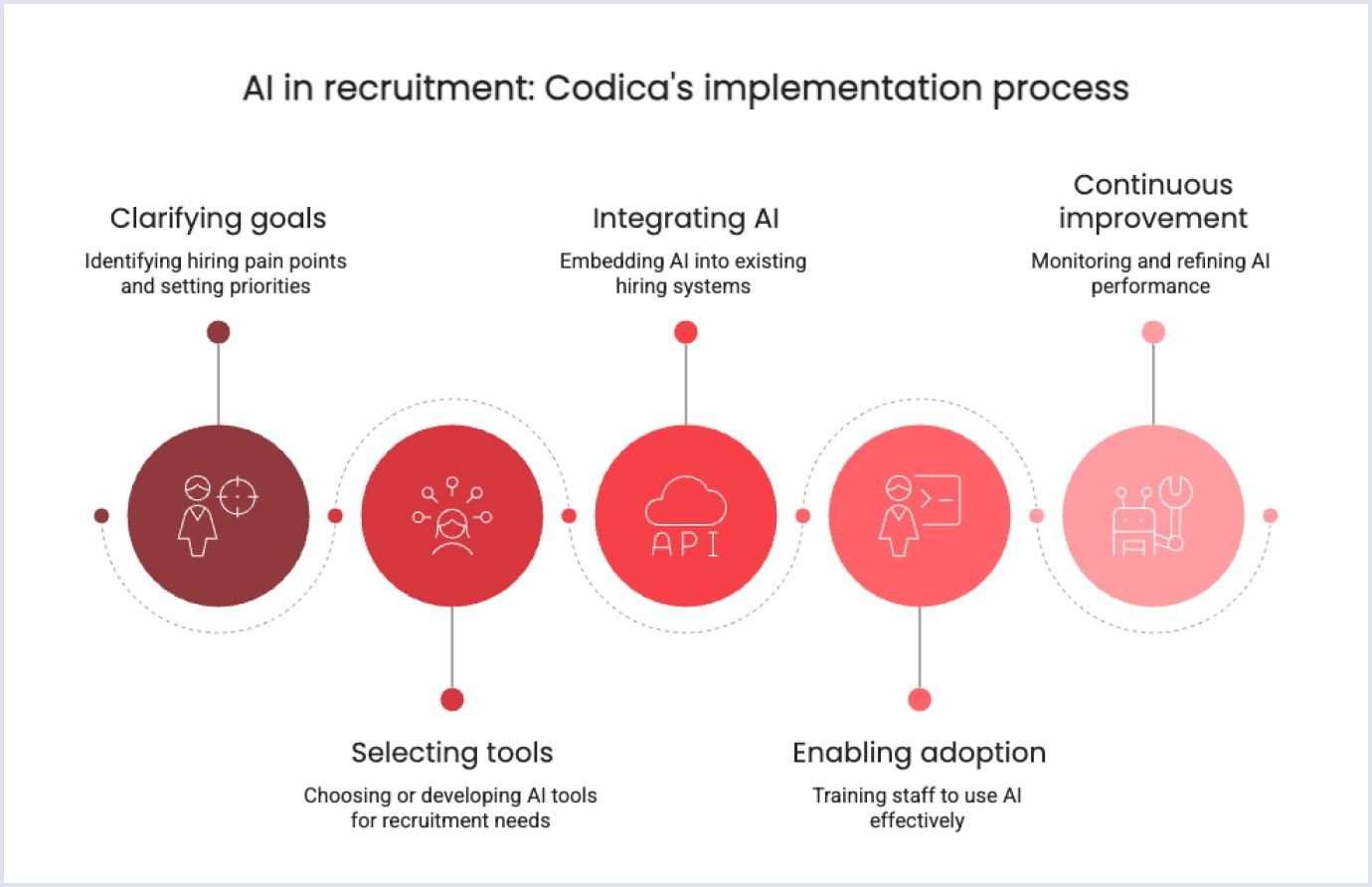
Step 1: Clarifying goals and identifying risk zones
Every project starts with a deep understanding of where you are and what you really need.
During the project discovery phase, we work with you to identify pain points in the hiring process: from identity theft during interviews to delays caused by manual screening or legacy technology. This allows us to focus on where AI will give you the fastest and most measurable returns.
Our product discovery process distills these insights into clear priorities and a well-defined feature set for your next-generation AI solution. Whether the goal is to detect fake credentials, speed up background checks or track behaviour in real time, we make sure the direction is aligned with your real hiring pain points.
We also consider how the solution will look and feel to your team. That's why we present your design system upfront to ensure the interface is intuitive, consistent and adoptable. The result isn't just a collection of AI features, it's a strategic foundation for long-term success.
Step 2: Selecting or developing the right tools
In line with the above objectives, we propose established AI modules or develop bespoke solutions using advanced machine learning algorithms. For example, if identity fraud is your concern, we integrate facial recognition with real-time live liveness detection. For document forgery, we use authentication AI to verify PDFs, certificates or transcripts at a structural level.
We always give tools a test, not just for functionality, but also for fluid integration into your recruiter and product experience. That's at the heart of our approach, one that serves to balance technical stability and actual usability.
Step 3: Smooth integration into your hiring platform
We work with your product and technology teams to embed AI modules directly into your hiring pipeline, from resume collection to interview insights and onboarding. Our developers integrate AI pipelines with your applicant tracking system, CRM, identity providers, or third-party verification platforms.
As one of the custom software development services, we provide complete compatibility with your existing infrastructure and data framework. All integrations are in accordance with your security and privacy standards, whichever of the two you are compliant with GDPR, SOC 2, or internal processes. We also help define how AI outcomes are displayed, with risk signs prominently displayed, override plans, and audit-friendly decision pathways.
Step 4: Enabling people and preparing for adoption
No AI system works if individuals don't use it with confidence. That's why we support your staff with tailored onboarding, training recruiters or hiring managers in the ability to interpret AI-driven insights, when to forward escalated suspect cases, and how to mix automation with human judgment.
We present live demos, offer hands-on training, and are on hand for follow-up as your staff learns. Our goal is simple: make AI accessible, understandable, and fully integrated into daily hiring decisions.
Step 5: Continuous improvement and measuring performance
After the launch, we are in touch. We measure the performance of the AI in real-world hiring situations, keep an eye out for false positives, and obtain direct recruiter input to continue fine-tuning the system.
As part of our ongoing quality assurance services, we also conduct functional testing, scenario validation, and stress tests to ensure the system remains robust and reliable over time. Fraud evolves, and so must your solutions. That's why we recommend continuous retraining of your models, periodic audits, and roadmap development for emerging AI features.
For us, delivery is never the end. It's a long-term commitment to smarter, safer hiring at scale.
Challenges and considerations
Artificial intelligence in recruitment is about responsibility. As algorithms begin to decide who to interview or hire, platforms are faced with high-stakes issues of fairness, transparency and control. These are four of the key challenges we help our clients address.
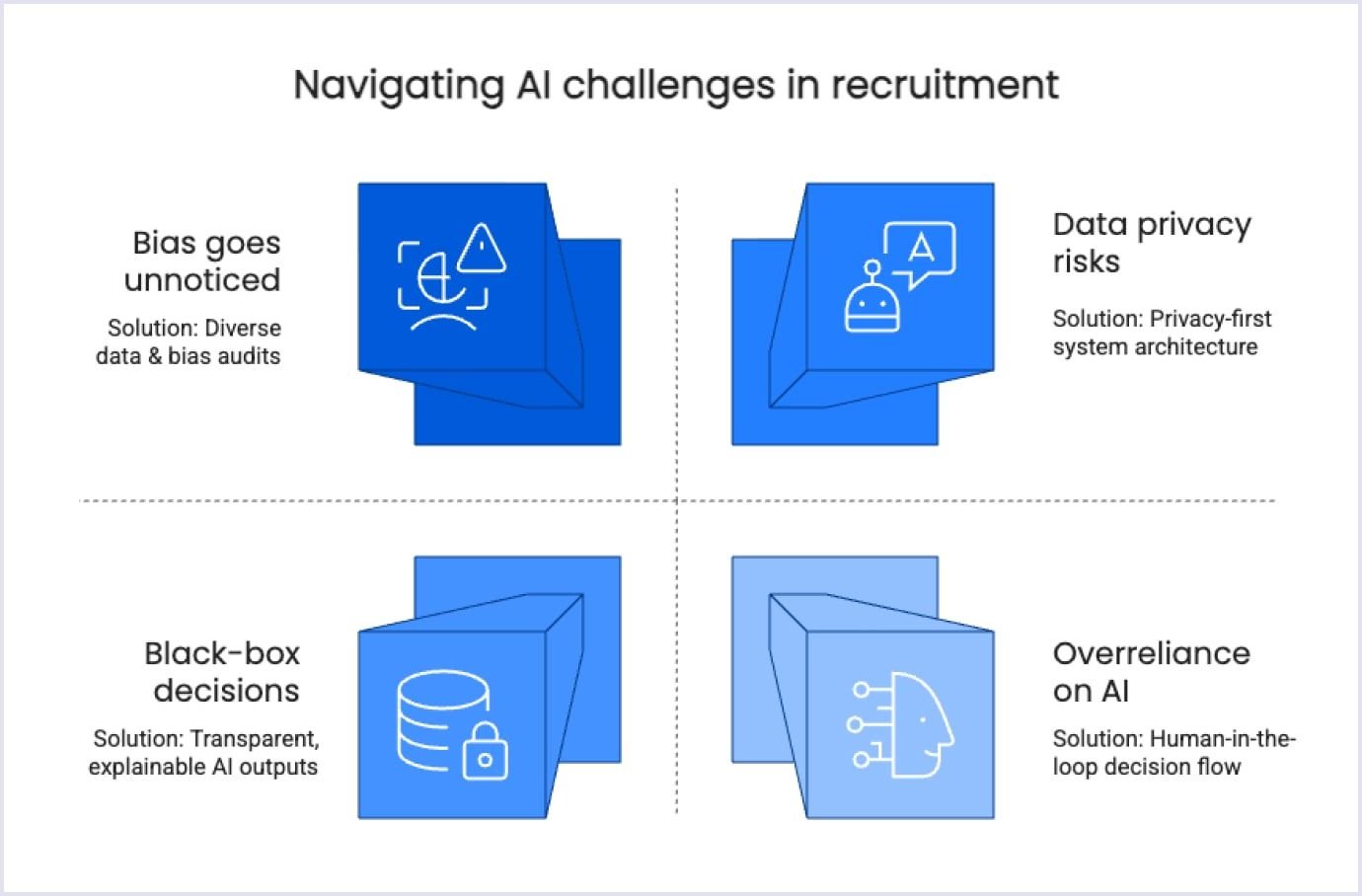
Challenge 1: Algorithmic bias becomes invisible until it's too late
When AI is trained on historical data, it can unconsciously perpetuate past discrimination, discriminating against candidates based on patterns of gender, ethnicity, or educational background. The worst part? It usually happens quietly, and no one knows about it.
Solution: We conduct bias audits during development, diversify training data, and test edge-case scenarios to ensure inclusivity from the start.
Challenge 2: AI says "no", but no one knows why
Black box algorithms are opaque. Recruiters can be left in the dark. When a worthy candidate is flagged or rejected on a whim, trust in the system is quickly destroyed.
Solution: We provide explainable AI output with visual signals and reasoning overviews so recruiters are aware of every automated action.
Challenge 3: Sensitive candidate data becomes a liability
AI requires vast amounts of personal data, from CVs to biometrics. Without strict controls, platforms can run the risk of non-compliance and even breaches.
Solution: Our systems are privacy-first by design: encrypted storage, access control layers, and full compliance with GDPR and other standards.
Challenge 4: AI becomes the decision-maker, not the co-pilot
It's tempting to want to rely entirely on automation, especially at scale. But without the human touch, platforms can lose context, nuance and even legal defensibility.
Solution: We build AI with human-in-the-loop logic, so that final decisions always include a recruiter's review, not just the machine's output.
From insight to implementation
Recruitment platforms face a clear challenge: identify fake candidates, verify quickly, and stay ethical. But AI-based recruitment is more than a filter. When implemented well, it's the foundation for smarter, safer and more ethical hiring. Achieving this requires more than turnkey solutions. It requires bespoke design, machine learning expertise, and a strategy built on transparency and real-world relevance.
At Codica, we've spent over a decade helping platforms integrate AI that doesn't just detect fraud, it creates lasting value. Have a look at our portfolio to see real-world results, or get in touch to find out how we can help you with your next product move.
